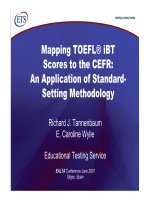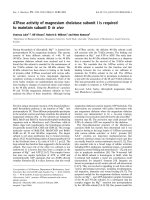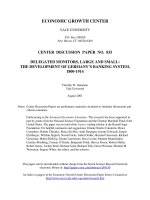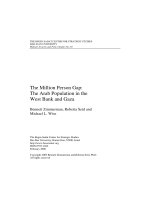The application of bowen’s family system theory (BFST) to the malay population in malaysia
Bạn đang xem bản rút gọn của tài liệu. Xem và tải ngay bản đầy đủ của tài liệu tại đây (1.8 MB, 177 trang )
THE APPLICATION OF BOWEN’S FAMILY
SYSTEM THEORY (BFST) TO THE MALAY
POPULATION IN MALAYSIA
RABA’ATON ADAWIAH BINTI MOHD YUSOF
Diploma in Islamic Studies, Advanced Diploma in Islamic
Studies, Master in Guidance and Counselling
Submitted in fulfilment of the requirements for the degree of
Doctor of Philosophy
Centre for Learning Innovation
Faculty of Education
Queensland University of Technology
[October 2011]
i
KEYWORDS
Bowen Family System Theory, Family counselling, multi-cultural counselling,
Malaysia, Social problems
The Application of Bowen‟s Family System Theory (BFST) to the Malay population in Malaysia
i
ii
ABSTRACT
The rapid economic development and social changes in Malaysia recently have led to
many psychosocial problems in young people, such as drug addiction, child sexual
abuse and mental illness. The Malaysian government is beginning to focus more
attention on its social welfare and human service needs in order to alleviate these
psychosocial problems. Although counselling is accepted and widespread in
Malaysia, the practice of family therapy is not as accepted as it is still a widely held
belief that family problems need to be kept within the family. However, changes are
imminent and thus the theoretical basis of family therapy needs to be culturally
relevant. Bowen‟s Family Systems Theory (BFST) is already one of the major
theories taught to tertiary counselling students in Malaysian universities. The main
tenet of Bowen‟s theory is that the family as a system may be unstable unless each
member of the family is well differentiated. High differentiation levels in the family
allow a person to both leave the family‟s boundaries in search of uniqueness and to
continually return to the family fold in order to establish a more mature sense of
belonging. The difficulty, however, is that while Bowen has claimed that his theory
is universal nearly all of the research confirming the theory has been conducted in
the United States of America. The only known study outside America, however, did
show that Bowen‟s theory applied to a Filipino population but, one of the theory‟s
propositions that differentiation is intergenerational was not supported in this nonAmerican sample. The American sample that was compared to the Malay sample
was taken from Skowron and Friedlander‟s (1998) study. One hundred and twentyseven faculty staff in an American university completed the Differentiation of Self
Inventory (DSI) to measure level of differentiation of self. This thesis therefore, set
ii
The Application of Bowen‟s Family System Theory (BFST) to the Malay population in Malaysia
iii
out to determine whether Bowen‟s theory applied to another non-American sample,
the Malaysian community. The research also investigated if the intergenerational
effect was present in the Malaysian sample as well as explored the role of socioeconomic status on Bowen‟s theory of differentiation and gender effect. Three
hundred and seventy-four families completed four measures to examine these
research questions: the Differentiation of Self Inventory (DSI), the Family Inventory
of Life Event (FILE), the Depression Anxiety and Stress Scale (DASS) and the
Connor-Davidson Resilience Scale (CD-RISC). The results of the study showed that
differentiation of self is a valid construct for the Malay population. However, all four
subscales of the Differentiation of Self Inventory (DSI); emotional reactivity (ER),
emotional cut-off (EC), fusion with other (FO) and I position (IP), showed
significant differences compared to the American sample from Skowron and
Friedlander‟s (1998) study. The Malay sample scored higher in emotional reaction
(ER), fusion with other (FO), but lower on emotional cut-off (EC) and I position (IP)
than the American sample. The intergenerational effect was found in the Malay
population as the parent‟s level of differentiation correlated with their children‟s
level of differentiation. It was found that stress as measured by the Family Inventory
of Life Event (FILE) and as measured by the Depression Anxiety and Stress Scale
(DASS) were not correlated with the level of differentiation of self in parents.
However, gender had a significant effect in predicting the level of differentiation
among parents in Malay population with females scores higher on emotional
reactivity (ER) and fusion with other (FO) than males. An additional finding was that
resilience can be predicted from the level of differentiation of self in children in the
Malay sample.
There was also a positive correlation between the level of
differentiation of self in parents and resilience in their children. Findings from this
The Application of Bowen‟s Family System Theory (BFST) to the Malay population in Malaysia
iii
iv
study indicate that the concept of differentiation of self is applicable to a Malay
sample; however, the implementation of the theory should be applied with cultural
sensitivity.
iv
The Application of Bowen‟s Family System Theory (BFST) to the Malay population in Malaysia
v
TABLE OF CONTENTS
Keywords ...................................................................................................................... i
Abstract ........................................................................................................................ ii
Table of Contents ......................................................................................................... v
List of Tables............................................................................................................. viii
List of Abbreviations................................................................................................... ix
Statement of Authorship .............................................................................................. x
Acknowledgments ....................................................................................................... xi
Introduction to the thesis ......................................................................................... 13
Thesis outline ............................................................................................................ 16
Chapter 1: Background ........................................................................................... 18
Growing social problems in Malaysia........................................................................ 20
Malaysia, Malay and Islam ......................................................................................................... 23
Malaysia‟s attempts to solve the problems ................................................................................. 25
Summary .................................................................................................................... 27
Chapter 2: Literature Review ................................................................................. 28
Counselling and culture.............................................................................................. 28
Cross-cultural counselling.......................................................................................... 31
Family counselling ..................................................................................................... 37
Family counselling in Malaysia ................................................................................. 39
Bowen‟s Family System Theory ................................................................................ 41
Differentiation of self ................................................................................................................. 45
Differentiation of self and research ............................................................................................ 50
Bowen‟s theory and universality ................................................................................................ 53
The intergenerational transmission process ................................................................................ 54
The family projection process .................................................................................................... 58
Bowen‟s theory and gender issues .............................................................................................. 60
Bowen‟s theory, life stress and economic status ........................................................................ 62
Resilience and Bowen‟s theory .................................................................................................. 66
Implications for counselling....................................................................................... 70
Research questions and hypotheses ............................................................................................ 71
American sample ........................................................................................................................ 73
Summary .................................................................................................................... 73
The Application of Bowen‟s Family System Theory (BFST) to the Malay population in Malaysia
v
vi
Chapter 3: Research Design .................................................................................... 77
Methodology and Research Design............................................................................ 77
Methodology ............................................................................................................................... 77
Method ........................................................................................................................................81
Measures ......................................................................................................................................85
Procedure .................................................................................................................... 92
Adult demographics.....................................................................................................................93
Child demographics .....................................................................................................................94
Summary .................................................................................................................... 95
Chapter 4: Results .................................................................................................... 97
Data cleaning ............................................................................................................................... 97
Descriptive statistics for each of the measures........................................................... 98
Reliability of the measures ......................................................................................... 99
Parental measures ........................................................................................................................99
Child measures ............................................................................................................................ 99
Summary .................................................................................................................. 108
Chapter 5: Discussion ............................................................................................ 111
Discussion ................................................................................................................ 111
Limitations ............................................................................................................... 122
Implications .............................................................................................................. 123
Recommendations .................................................................................................... 125
References ............................................................................................................... 129
Appendices .............................................................................................................. 142
Appendix A: Participant information sheet (English version) ...................................................143
Consent form (English version) .................................................................................................145
Participant information sheet (Malay version) ..........................................................................146
Consent form (Malay version) ...................................................................................................148
Permission letter from the District Officer ................................................................................149
Appendix B: ............................................................................................................ 153
Survey instrument for parents (English version) ................................................ 153
Demographic questions ...........................................................................................................153
Differentiation of Self Inventory ............................................................................................ 154
FILE..........................................................................................................................................156
DASS21 .....................................................................................................................................158
Survey instrument for parents (Malay version) .................................................. 159
Soalan kaji selidik (penjaga)......................................................................................................159
Differentiation of Self Inventory ............................................................................................ 160
vi
The Application of Bowen‟s Family System Theory (BFST) to the Malay population in Malaysia
vii
DASS21 .................................................................................................................................... 163
FILE ......................................................................................................................................... 164
Appendix C: ............................................................................................................ 167
Survey instrument for children (English version)............................................... 167
Demographic questions .......................................................................................................... 167
Differentiation of Self Inventory ........................................................................................... 168
Connor-Davidson Resilience Scale ........................................................................................ 170
Survey instrument for children (Malay version)................................................. 171
Soalan kaji selidik (anak).......................................................................................................... 171
Differentiation of Self Inventory ........................................................................................... 172
Connor-Davidson Resilience Scale ........................................................................................ 175
The Application of Bowen‟s Family System Theory (BFST) to the Malay population in Malaysia
vii
viii
LIST OF TABLES
Page
Table 1. Descriptive statistics for parental measures .....................................98
Table 2. Descriptive statistics for children measures......................................99
Table 3. Reliability of the measures................................................................100
Table 4. Results of the test of significance comparing the means of the
DSI full scale and subscale score for the Malay and European
American samples.......................................................................................... 102
Table 5. Multiple regression analysis of demographic variable; gender,
educational status and income as predictor to the parents‟ level of
differentiation of self .....................................................................................104
Table 6. Hierarchical regression analysis for FILE and DASS in explaining
variance of the DSI in parents over the demographic variable of gender,
income and educational status .......................................................................105
Table 7. Hierarchical regression analysis for CD-RISC in explaining variance
of the DSI in children over the demographic variable ..................................107
viii
The Application of Bowen‟s Family System Theory (BFST) to the Malay population in Malaysia
ix
LIST OF ABBREVIATIONS
SES: Social economic status
DSI: Differentiation of Self Inventory
DASS: Depression, Anxiety and Stress Scale
FILE: Family Inventory of Life Events
CD-RISC: Connor- Davidson Resilience Scale
ER: Emotional reactivity
EC: Emotional cut-off
FO: Fusion with other
IP: I position
The Application of Bowen‟s Family System Theory (BFST) to the Malay population in Malaysia
ix
x
STATEMENT OF AUTHORSHIP
The work contained in this thesis has not been previously submitted to meet
requirements for an award at this or any other higher education institution. To the
best of my knowledge and belief, the thesis contains no material previously
published or written by another person except where due reference is made.
Signature : ________________________________________
Date : 05 October 2011
x
The Application of Bowen‟s Family System Theory (BFST) to the Malay population in Malaysia
xi
ACKNOWLEDGMENTS
In the name of Allah, the most gracious and merciful
Doing a PhD is like a dream within a dream for me. It really needs patience,
intuition, resilience, support and faith in God. I have nearly given up when faced
with the obstacles, but there were my family, my supervisor, my friends and the most
important one, God, who always gives me strength. Even though there is everybody
around me, a PhD is still a lonely journey that I have had to travel alone. Emotional
supports from family, guidance and lots of help from supervisors, encouragement
and sharing from friends and confidence from God have helped me to proceed till the
end.
I would like to express my deepest gratitude to Associate Professor Marilyn
Campbell, my principal supervisor, who has always been patient with me, especially
with my English language. Her support, guidance and assistance along this lonely
journey are really appreciated. The same goes to my associate supervisor Professor
Ian Shochet, who gave his valuable time and effort in providing consultation in
completing this project.
Special appreciation goes to my family especially my husband, Hussin, who
willingly took care of our two heroes while I was struggling with my study; I really
owe you. Thank you for staying with me, giving me emotional support and having
confidence in me when I really need it. To my heroes, Haziq and Hanif, I want each
of you to realise that I am doing this for both of you. For my mother, and all of my
siblings, your prayers are really valuable to make sure I will complete this journey
successfully.
The Application of Bowen‟s Family System Theory (BFST) to the Malay population in Malaysia
xi
xii
To all my friends, Dilla, Zrett, Cik As, Elizabeth, Hossein and Lutz. We will fight till
the end and yes we can do this! Thanks for being such good friends to me. To CLI
staff, Jennifer Yared; thanks for making me feel comfortable even though I am far
away from my mother. You always offered me a shoulder to cry on which I really
appreciated. Alicia Alan who helped me with thesis writing and Janine Beck who
helped me with statistical analyses, thanks a lot.
Finally, without the gracious and merciful strength from God, I would not have been
able to complete this project. Thanks Allah for giving me this opportunity and
always
xii
guiding
me
to
complete
this
lonely
journey.
The Application of Bowen‟s Family System Theory (BFST) to the Malay population in Malaysia
INTRODUCTION TO THE THESIS
Bowen‟s Family System Theory (BFST) is regarded as one of the most fully
developed theories emerging from family therapy (Nichols & Schwartz, 2005).
Bowen conceptualises the family as an emotional unit where a child learns and grows
in an emotional environment. This unit links individuals in the family together as a
system but this system may be unstable unless each member of the family is well
differentiated (Bowen, 1978; Kerr & Bowen, 1988).
Bowen introduced eight interlocking concepts as a base for this family theory. These
concepts are: (1) differentiation of self - the ability to differentiate the intellectual
process from the feeling process within oneself; (2) triangles - the process of
including a third person when there is stress between two people in a family; (3) the
nuclear family‟s emotional system - the patterns of emotional functioning in family
in a single generation; (4) the family projection process - the process of stress
projection onto one child; (5) emotional cut-off - the way of dealing with stress by
emotionally withdrawing from the family; (6) the intergenerational transmission
process - the process of transferring differentiation of self from generation to
generation; (7) sibling position - birth order can possibly have an impact on the
functioning of children within family (Sharf, 2008), and (8) societal regression - the
concept of differentiation in the family has been extended to the society. As this is a
preliminary study to investigate the implementation of Bowen‟s theory in the Malay
population in Malaysia, only concepts that relate to differentiation of self; the family
projection process and the intergenerational process will be examined.
Introduction to the thesis
13
14
From all of those concepts, differentiation of self is regarding as the key concept of
Bowen‟s theory. According to Bowen (1978), differentiation is learnt in the family of
origin and passed down through the intergenerational transmission process via the
family projection method across generations within a family (Bowen, 1978; Kerr &
Bowen, 1988). Differentiation of self refers to the ability to balance on two levels;
first, the intra-psychic level which is the ability to differentiate between one‟s feeling
and thinking processes, and second, the interpersonal level, which is the capability to
distinguish between togetherness and autonomy in relationships (Kerr & Bowen,
1988). It is the ability to be yourself while still connecting with others in the family.
Bowen argues that the differentiation of self is also a product of the intergenerational
transmission process. Different levels of differentiation of self in children are largely
predicted by the differentiation levels of the parents (Bowen, 1978). This
transmission process occurs at an emotional level through the „family projection
process‟ and normally levels of projection vary among children according to how
differentiated their parents are (Kerr & Bowen, 1988).
Although Bowen‟s Family System Theory (BFST) was developed in the Western
world, specifically in United States, it has spread to Eastern cultures because of the
interest and development of counselling skills and theories in these countries to
combat their problems and because Bowen (1978) assumed that his theory was
universal and applicable to all cultures. Bowen does not seem to have considered that
different cultures might have different family structures and processes which could
alter the application of his theory and ultimately affect its successful implementation
to family counselling. For example, in traditional Malay culture, family refers to all
14
Introduction to the thesis
15
kin and neighbours who live nearby and help in the child raising process. This
definition of family may vary in other cultures and certainly does in Western cultures
which emphasis the individual over the group (Harun & Hamzah, 2006). However,
Bowen could be correct and his theory might be universally applicable to all cultures.
Nonetheless, at the present time, only limited studies have been conducted to
examine this proposition (Chung & Gale, 2009; Peleg, 2005; Tuason & Friedlander,
2000), and no studies have been done, to date, taking Bowen‟s theory in the context
of Malay families and family dynamics.
Because of economic development and more exposure to the Western world, changes
are becoming evident in Malay families‟ approaches to problems within the family.
In the traditional Malay culture, the family is considered to be sacrosanct and is
heavily influenced by religion. Family problems are not to be talked about outside
the family (Ng, 2003) making family counselling often unpalatable to many Malays
who seek assistance when they have concerns. However, as explained below, the
Malay culture is changing and counselling is being sought more often (Kling, 1995).
On the other hand, cultural and religious issues are still involved in family
counselling and these issues need to be handled sensitively. For instance, Malay
speakers tend to be very careful about commenting on and opposing another person‟s
views especially when they are about family members (Goddard, 1997). This
reluctance could cause misinterpretations in family counselling if the counselling is
not culturally sensitive.
Bowen‟s Family System Theory (BFST) is one of the major theories that is taught to
Malaysian university counselling students, in relation to family counselling.
Introduction to the thesis
15
16
However, there is no evidence that Bowen‟s theory and the subsequent family
counselling practices are applicable to and appropriate for the Malay population.
Therefore, this thesis examined the validity of the major components of Bowen‟s
theory in Malaysia to a Malay population; namely, the concept of differentiation of
self and the intergenerational process of differentiation of self.
THESIS OUTLINE
Chapter 1 discusses the background to the study. The problems in Malaysia are
presented such as drug addiction, child sexual abuse and young people‟s
deteriorating mental health together with the actions that have been taken by the
Malaysian government to alleviate these problems. These actions have been mainly
based on providing family counselling to families whose children have been
adversely affected.
Chapter 2 reviews the related literature on counselling in general and family
counselling specifically. The cultural aspect of counselling and the relevant research
are discussed. The implementation of family counselling in Malaysia and its
expected benefits are presented. This is followed by a discussion about the research
that has been conducted relating to Bowen‟s Family System Theory and the concept
of resilience.
Chapter 3 discusses the research methodology used in this study including the
justification for using quantitative research methodology. The measures are
16
Thesis outline
17
described including the way in which the measures were translated and piloted
tested.
Chapter 4 describes the results of the study. The data was analysed by SPSS.
Chapter 5 discusses the findings of the study in relation to the literature reviewed,
concludes the thesis by discussing the findings in the context of Malay culture and
presents implications for counselling and counsellor training in Malaysia.
Limitations and recommendations for future studies are then presented.
Thesis outline
17
18
CHAPTER 1: BACKGROUND
Malaysia consists of three major ethnic groups; Malay, Chinese and Indian. These
groups are not only separated by their historical background, but also by their way of
life. In the present study, only the Malay people as the largest ethnic group in
Malaysia will be examined. This is not only because they are the largest ethnic group
in Malaysia but also because of the uniqueness of the Malay traditions that are more
susceptible to modern day challenges and changes. This is especially true of the
differences in religion. As stated in the Malaysian constitution, all Malays are
Muslim by definition and in practice (Kling, 1995). As a result of British colonial
policy, Malays historically were mainly engaged in agriculture and fishing and lived
a rural way of life, whereas non-Malays, Chinese and Indians were involved in
business and entrepreneurial activities (Crouch, 1996). However, after the
implementation of the National Economic Plan (NEP) in 1970, changes in the pattern
of life within the Malay ethnic group have been increasingly observed. The Malays
have been encouraged to avail themselves of the opportunities provided by the
government to become involved in business and further their professional studies
(Mastor, Jin, & Cooper, 2000). The new economic policy has changed the attitude of
Malays and stimulated economic development among Malays, thus leading to a
better quality of life.
Along with the development of the economy, however, there have been a number of
difficulties and negative outcomes such as social problems among young people.
Malaysia‟s transition from a British colony to an independent country in 1957
brought a range of changes and challenges. As a third world economy, Malaysia has
experienced a very rapid economic development in the 1990s before the East Asian
18
Chapter 1: Background
19
economic crisis. One of the biggest challenges resulting from this developing
economy is the change in the traditional family institution (Harun & Hamzah, 2006;
Zaini & Rahman, 2006). For example, in the traditional Malay family, the father is
the breadwinner and the mother is a full time house-wife who raises the children and
runs the household. However, with the economic improvement often both parents
now are working and have less time with their children. This could be one of the
factors contributing to the increased social problems among the Malay‟s young
people.
The term “development” is generally used to describe a better life for the population
(Goulet, 1992). As well as the quantitative aspects of development in the form of
wealth creation, qualitative aspects which are non-economic in form also need to be
considered (Amin, Yusof, & Haneef, 2006). For example, the change from an
agriculturally-based economy to an industrially-based one has had many benefits for
Malaysia, especially in the reduction of poverty and enhancing the population‟s
quality of life.
While economic development has provided substantial opportunities for growth in
Malaysia, it has not been generally accompanied by an improvement in human wellbeing. Young people have been identified as an important indicator that determines
the quality of life of a society because they possibly can impede the progress towards
attaining further development in the future (Cartwright, 2000). Therefore, to improve
the quality of life and achieve social well-being in economic development, social
problems that exist in society especially involving young people need to be reduced
(Amin et al., 2006).
Chapter 1: Background
19
20
Growing social problems in Malaysia
Rapid economic development and social changes have lead to many psychosocial
problems in Malaysia. The increasing number of social problems such as drug
addiction, child sexual abuse and mental illness, particularly among Muslim (mainly
Malay) teenagers in Malaysia has the potential to impede economic development and
the creation of a well-balanced society in the future. For instance, criminal cases
involving juveniles have increased by 62 percent from 2408 cases in 1980 to 4012
cases in 1995. In the period of 1990-1995, 60 percent of the juvenile cases involved
teenagers aged between 16 and 18 years (Malaysia, 1997). Drug addiction, child
sexual abuse and mental illness are commonly reported in the daily news. These
psychosocial problems are major challenges faced by community leaders, parents,
teachers, college and university educators and also the helping professionals in
Malaysia at present. To ensure a better quality of life for present and future
generations attention needs to be directed at today‟s teenagers and their mental
health. It is imperative that the problems and mental health issues faced by
adolescents are addressed.
Present day young people have been the first generation to grow up in the era of
globalization in Malaysia. They have been exposed to all kinds of modern
technologies from the West that afford them many advantages compared to previous
generations. They have more regular primary education, greater access to different
styles of thinking and have more information about people around the world.
However, being the first generation that has been exposed to the new technologies
and new „role models‟ has also brought a certain degree of culture shock which
continues to challenge their parents, society and the government. Exposure to
20
Chapter 1: Background
21
information from the West is having an influence on traditional values such as ways
of dressing, communicating, behaving and thinking. As mentioned before, ethnic
Malays in Malaysia are Muslim. As a result, traditional values are generally based on
religious beliefs and are different from those in Western societies.
One of the major social problems in Malaysia, especially amongst young people is
drug addiction. The total number of drug users recorded for the period of 1988 to
2006 was 300,241 (NADI, 2005). However, this number included only those
individuals who were caught by or reported to the authorities. This is still
approximately 1.1% of Malaysia‟s total population of whom 70% are youths aged
between 19 to 24 years-old. Most of these young addicts are dependent on heroin
(NADI, 2005). Close geographical proximity to the Golden Triangle and other
Southeast Asian countries that produce heroin is the major reason given for the
increasing number of domestic drug users.
However, drug addiction is not only a problem itself, it also relates to an increasing
HIV problem in Malaysia. This is because needle sharing is the most common means
of HIV transmission (Mazlan, Schottenfeld, & Chawarski, 2006). There were 61,641
detected cases of HIV from 1986 to September 2004 (Ministry of Health, 2005)
giving Malaysia, after Vietnam, the second highest HIV prevalence among adult
populations in the Western Pacific regions. As well as the medical burden presented
by high rates of HIV, this situation has cascading effects leading to homelessness,
crime and missed work or problems with keeping a job. The situation is crucial for
Malaysian society and Malaysian families.
Chapter 1: Background
21
22
Sexual abuse is also a growing problem in Malaysia. There is an increasing number
of sexual abuse cases reported each year. From 2002 to 2006, there were 6861 cases
of child abuse reported (Department of Social welfare, 2007). While previously most
sexual abuse cases involved adults, at present there is an increasing incidence of
sexual abuse of children and even babies. Most sexual abuse cases occur within the
family household with the perpetrator being well known to the victim (Kassim &
Kasim, 1995).
Child sexual abuse is known to have long term negative
consequences with adult survivors more prone to depression, anxiety, low esteem
(Ullman, 2003), alcohol and drug addiction, psychosexual and relationship
difficulties and suicidal ideation (Tyler, 2002). A history of sexual abuse or rape is
related to a variety of HIV risk behaviours and to an increase in the total number of
such behaviours between adolescence and young adulthood (Tyler, 2002).
Mental illness is also a significant and rapidly escalating problem in Malaysia at
present. In Malaysia, mental illness is not regarded as a disability but is viewed as a
purely medical problem. Sufferers from mental illness such as anxiety, depression
and schizophrenia are commonly linked with crime and deviance (Crabtree & Chang,
2000). Mental health can be considered as a reflection of healthy or positive
behaviour on the part of the individual and also in relation to one‟s culture (Haque,
2005). Every culture and every person may have a different perspective on what
constitutes mental health. According to the National Policy on Mental Health
Malaysia, mental health is defined as “the capacity of the individual, the group and
the environment to interact with one another to promote subjective well-being and
optimal functioning and the use of cognitive, affective and relational abilities,
22
Chapter 1: Background
23
towards the achievement of individual and collective goals consistent with justice”
(National Policy of Mental Health Malaysia, 2000, p, 12).
Approximately 1% of the Malaysian population suffers from schizophrenia (Rosli,
2008). According to the Malaysian Health Minister, one in four Malaysians suffers
from stress-related problems. Also, six in one hundred Malaysians have suicidal
tendencies, with 16 to 24-year-olds forming the biggest group (Thye, 2008). People
with a mental illness will face numerous problems which are sometimes beyond their
abilities to cope. They will depend on other people to help them with their lives. In
this situation they find it difficult to make a contribution to society and are often a
burden to their families. When services are not available mental illness has a
negative impact on society, especially in remote regions.
Malaysia, Malay and Islam
One of the reasons for the breakdown of traditional society in Malaysia is the
weakening of religious practices especially in family systems. In Malaysia, Malays in
past years had always been Muslim. In fact the Malaysian Constitution clearly
defines Malay as:
“ a person who professes the religion of Islam, habitually speaks the Malay
language, conforms to Malay customs…” (Malaysia: Federal Constitution,
160(2)).
Thus for Malays, Islam guides all of their decisions throughout their lives and is an
important socio-cultural value in Malaysia (Varma & Zain, 1996).
Chapter 1: Background
23









